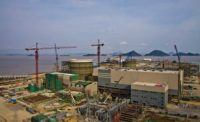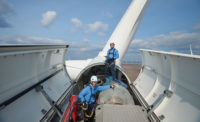A second hydrogen blast occurred at the Fukushima Daiichi nuclear plant in northern Japan at 11 a.m. local time March 13, but the explosion in the reactor building of Unit 3 left the primary containment vessel intact, says the the International Atomic Energy Agency.
The unit’s control room remains operational, says the IAEA.
A hydrogen gas blast at Unit 1 on Saturday destroyed that unit’s containment building’s outer shell but also did not damage the core reactor building, say Japanese officials.
Late on March 13, officials of the Tokyo Electric Power Co. (TEPCO) were attempting to reduce the concentration of hydrogen inside the containment building.
But according to the Nuclear Energy Institute (NEI) in Washington D.C, Japan Chief Cabinet Secretary Yukio Edano said March 13 that officials are acting on the assumption that at Unit 3 meltdown could be underway.
The reactor problems began March 11, following the 9.0 earthquake and tsunami that hit Japan later in the day. The quake cut off power to the plant, and diesel generators intended to provide back-up electricity to the facility’s cooling system were disabled by tsunami flooding.
TEPCO engineers were flooding units 1 and 3 with seawater and boron, which appeared to be working in unit 1; but the water level in unit 3 was not rising. Japanese officials were venting radioactive gas from unit 3 to prevent pressure buildup.
TEPCO tried to flood the reactors with fresh water on March 12, but used seawater when that effort failed. However, the seawater and boron mixture will more than likely permanently cripple the units, experts say.
Late on March 11, IAEA Director General Yukiya Amano, a native of Japan, said that the Japanese authorities are working to handle the “difficult and constantly evolving circumstances.” While IAEA’s role in such nuclear crisis is to coordinate assistance from other members, Amano said that Japan has not yet asked for assistance.
Japan has declared the reactor problems a 4 on a scale of 1 to 7, with 4 as an accident with local consequences, and 7 as a major accident.
Secretary of State Hillary Clinton said Friday that the United States had sent coolant to Japan, but it was unclear whether it had been used. The U.S. Nuclear Regulatory Commission said it has sent two experts to Japan to assist, but would not comment on the hour-to-hour developments there and said that measures being taken by the Japanese government are consistent with what the U.S. would take.
NRC officials say that the commission is monitoring radioactive releases and that Hawaii, Alaska, U.S. territories in the Pacific and the U.S. West Coast are not expected to experience any harmful levels of radioactivity.
Nuclear Power’s Future
Despite speculation on the disaster’s impact on new nuclear power construction in the U.S. and elsewhere, J.M. Bernhard Jr., chairman of Baton Rouge-based The Shaw Group, which is building two AP1000 design units by Westinghouse Co. in the U.S., expressed confidence in the new design and nuclear power’s future.
“We continue to believe in the importance of nuclear energy and the role it will play in the future of our country, as well as the rest of the world,” he said in a March 13 statement. “The new generation technology under construction today has been designed with greater safety systems in place that will even more effectively address the challenges we are seeing in Japan. The industry consistently incorporates operating experience and lessons learned and will continue to use those insights to make nuclear energy even safer.”
Bernhard contended that “at this time, we do not believe there will be an impact on Shaw’s nuclear projects currently under construction in the United States and China. Our customers have indicated they intend to move forward, and we believe the construction timelines will continue as planned.”
But at least one analyst believes that Shaw will be impacted. Avram Fisher, industry analyst for BMO Capital Markets, New York City, said March 14 that investors "considering a swing in the pendulum toward coal over nuclear" may consider selling holdings of Shaw, which he said is "the largest nuclear-exposed" engineering and construction firm.
Shaw’s stock took a hit on the news on a day when nuclear stocks and related businesses in general took a tumble in the markets. At the start of trading on the New York Stock Exchange, Shaw (NYSE:SHAW) shares had slipped by 19 percent. But by the last hour of regular trading, its shares had recovered to $32.83, down by 14.55% on the day.
Fisher added that the trend to coal could favor Fluor Corp., which is strong in the sector, as well as Foster Wheeler Corp. and URS. Shares of Fluor (NYSE:FLR) had gained 2 cents on the day to $68.97.
Also, Japan's shift to liquefied natural gas (LNG) and thermal coal to offset the decline in nuclear generation could "pressure" LNG prices in the Pacific basin, a trend that would benefit construction volumes for Foster Wheeler, Chicago Bridge & Iron and KBR.
KBR was awarded a front-end engineering design contract earlier this month on the proposed Kitimat LNG terminal in British Columbia, estimated to cost $3 billion. "Expect a sustained increase in LNG prices to lead to additional proposals to export North American natural gas into Asian markets," said Fisher.
Fisher also contended that the quake's financial impact on Japan may delay its payment of about $6 billion toward financing the estimated $15-billion buildup of infrastructure on Guam to accommodate transfer of US military personnel from the Japanese island of Okinawa.
Japan's payment is part of a treaty with the U.S. The analyst speculated that such financing impacts could be a "negative" for contractors Tutor-Perini and Granite Construction.


























Post a comment to this article
Report Abusive Comment